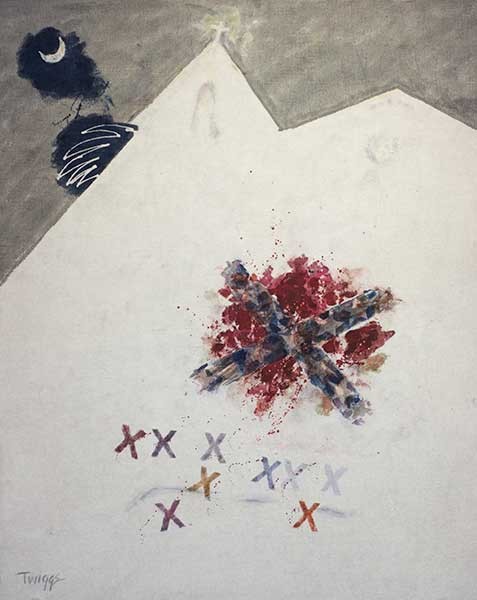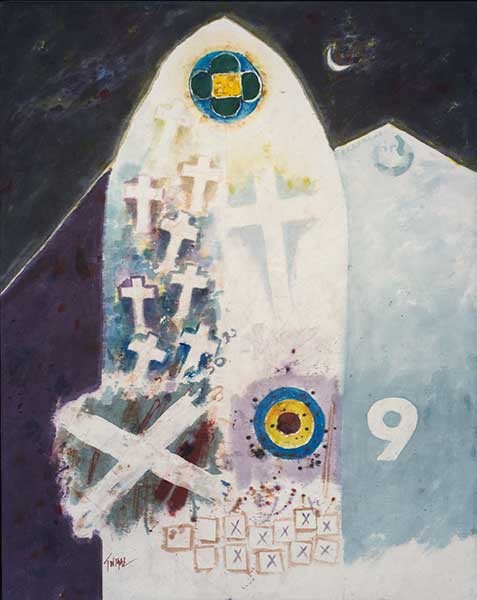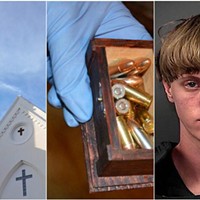We have come over a way that with tears has been watered.
We have come treading our path through the blood of the slaughtered.
—James Weldon Johnson, "Lift Ev'ry Voice and Sing"
When a pistol-toting white supremacist walked into historic Emanuel AME Church in Charleston, S.C., in June 2015, and gunned down nine worshippers, the massacre was a stark reminder that racial hatred is as virulent today as it was in September 1963, when spineless white supremacists bombed the Sixteenth Street Baptist Church, in Birmingham, Ala., killing four young girls.
Or when cowardly white supremacists in Charleston burned the Emanuel church to the ground during its first recorded attack — in 1822.
"This was not the beginning of our story, nor is it the end of our story," artist Leo Twiggs says of the most recent incident. "It happened before in Birmingham, it happened to Emmett Till, it happened to Martin Luther King. It is just one segment of the stony road we've trod."
Twiggs' poignant exhibit Requiem for Mother Emanuel, a series of nine batiks representing spiritual transformation, is currently showing at the Mint Museum on Randolph Road in Charlotte. It's no coincidence the show falls during the trial of Charleston shooter Dylann Roof, and in the aftermath of the September uprising spurred on by the Charlotte police shooting of Keith Lamont Scott.
"One of the main reasons I wanted this series in Charlotte is because of what Charlotte recently went through," Twiggs says. "And what happened in Ferguson. And what's happened in so many other places across the country. I wanted people to know that these things are not unique for African-Americans."
Twiggs was born 45 miles north of Charleston in St. Stephen. At 36 he became the first African-American student to receive a Doctorate of Arts from the University of Georgia in Athens. The following year, the young painter began working with batik, a method of decorating textiles using dyes and wax. "I was just taken by the subtle color qualities of the batik — the softness of it, the fact that it could be a medium associated with introspection rather than display," Twiggs says, speaking from his current home in Greenville, S.C. "Because colors on batik seep into fabric, the viewer looks into the work rather than at a flat surface."
In 1971, Twiggs wanted art lovers to look more deeply into the meaning of the Confederate flag, so he began experimenting with various perspectives on the flag's red background and massive blue, star-dotted St. Andrews cross. "What struck me back then about Confederate flags is that people were flying them as if the war was still going on," Twiggs says. "You'd see the flag displayed on antebellum houses, and even above the state house here in South Carolina. It always fascinated me that in the South some people never got over the fact that the war was gone with the wind, as Margaret Mitchell said. It's over. So my flags were tattered — worn-out images of a symbol from another time.
"But then, of course, the flag had become something else," Twiggs continues. "It was appropriated for another reason, and that reason is hate."
Two decades later, Twiggs showed the flags in a series called Commemoration. By then, he'd begun exploring another symbol, targets, in a series called Targeted Man. "That series had come out of my fascination with the fact that when I was growing up in the South, the Ku Klux Klan would target blacks," Twiggs says. "These were people you'd see every day. They'd talk to you and you'd be working for them. And then at night they'd put on their sheets."

- SailWind
- Leo Twiggs (1934- ), Requiem for Mother Emanuel #4, 2016, batik on cotton. Collection of Lynn and Flavia Harton. The Johnson Collection.
He remembers a story his brother told about riding around with a white guy in a pickup truck when the guy asked him to reach under the seat and grab something. "So my brother reaches down and pulls out something else — the head of a KKK sheet. The guy says, 'No, put that back! Put that back!' Knowing him, we suspected he was probably one of them, but this made it clear."
When terrorists flew planes into the World Trade Center on Sept. 11, 2001, Twiggs' idea of the Targeted Man took on a whole new meaning. He'd long been surprised that newscasters often referred to terrorists in other countries, but didn't call the KKK a terrorist organization. "Nobody ever called them terrorists," he says. "But when 911 happened, everybody was targeted, not just African-Americans. And just like back then, you didn't know who the enemy was. So I explored that in my art."
News of the Emanuel church shooting in 2015 hit Twiggs hard. And like always, he worked through his feelings by putting images onto fabric. This time, he combined both of his old themes. "Dylann Roof was influenced by hatred, and the Confederate flag was the symbol of his hatred," Twiggs says. "And then he targeted the church. He rode around Charleston five or six times and decided on that church because of its historical background. So here are two ideas I had been exploring all my life and all my career."
Twiggs started with a silhouette of the church. Then he put a target on it. In a second piece, he incorporated a target and a flag. Greenville resident and Spoleto board member Jennifer Whittle asked if Twiggs would do a piece for an auction to raise funds for the annual arts festival. "Jennifer is a very good friend and we've been on boards together, so I said, 'OK, I'll give you something.' It's the smallest piece in the show, the third piece."
A photo of that piece — which also included an X for each victim — went viral. "People were talking about it on the internet," Twiggs says.
By January 2016, Twiggs' work had prompted a national conversation among lovers of art. "Jennifer said to me, 'Why don't you do nine paintings?'" — one for each victim. "That was a tall order," Twiggs says, and laughs. "It takes me on average a month or so to do a piece, because it's so time-consuming. With batik, you have to let the dyes dry and..." He trails off. "But doing nine pieces intrigued me, because I'd put the number 9 on one of the paintings already."

- SailWind
- Leo Twiggs (1934- ), Requiem for Mother Emanuel #7, 2016, batik on cotton. The Johnson Collection.
But Twiggs was emotionally stuck. "I had really got inside of myself and lived with that tragedy," he says. "I knew that if I continued, the bloodiness and the pain and the horror was going to affect me." For the next three pieces, he needed to move away from the brutality. "I had to somehow transition from that bloodiness to the redemption the survivors had displayed after the incident. It was very cathartic for me."
In the next three paintings, the Confederate flag became less prominent. "The red was just bloodstains instead of the redness of the flag, and the flag became smaller," Twiggs says. "Eventually, that St. Andrews Cross transitioned into a Christian cross." In the final three, Twiggs found the redemption he was looking for. But he had to go inside the church for that.
It was a Wednesday evening and parishioners were holding a Bible study, just as they were the night Dylann Roof arrived. They invited Twiggs in, just as they had for Roof. "Here we were, less than six feet from where it happened, and they welcomed us with open arms, and it just kind of let me know how they had welcomed Dylan Roof in the same way," Twiggs remembers. "They served us food, and we ate with them, and I kidded one of the members, telling her she reminded me of my mom."
Twiggs looked up at the stained-glass window above the pulpit. "It's a very prominent, elegant piece," he says. "I was thinking that for these people who sit in this church every Sunday morning, maybe that's their portal, their souls' portal out to the beyond. You know, black people don't think of funerals as funerals — they think of them as home-going ceremonies. People don't die, they transition to another life. That's why the spiritual says, 'Swing low, sweet chariot, coming for to carry me home.'"
Twiggs was thinking of several old hymns when he began the final stretch of his requiem. "In the Christian religion, Christ was crucified, transitioned, and then ascended to heaven," he says. "And many painters have explored this, like Michelangelo." Twiggs wanted to depict the idea of worshippers modeling their lives on Christ. "He said, 'Father forgive them, for they know not what they do,' and these people also said, 'I forgive you.' And that's powerful."
Forgiveness is not easy, particularly when it involves forgiving a monster. "But as I painted, I began to understand more and more how these people came to that conclusion," Twiggs says. "One of the things you have to do when you're painting is that, even though it impacts you, it shouldn't be so personal that you can't get outside of yourself and look in on it. You have to be able to do that, because it's not really about you, it's about them."
Malcolm Graham, a former North Carolina senator from Charlotte, is one of them. He lost his sister, Cynthia Hurd, in the shooting. Graham first saw Twiggs' early images of the shooting shortly after the tragedy, and he was overwhelmed. "It's just a powerful presentation, where art has been able to capture all that pain and suffering," says Graham, who plans to see the work again at the Mint this month before conducting a presentation on Feb. 8.
"I was so caught up in my emotions when I first saw the works, it was a bittersweet experience — the images are so strong and poignant," Graham says. "I've had time to process it now, and I think I'm in a better place to appreciate the art even more — to understand it better, to speak to what the artist was trying to articulate through his images."
The Rev. Sharon Risher of Charlotte lost her mother and two cousins in the attack. Her feelings on the larger meaning of Twiggs' art seems to echo those of Graham. "The history of the church and what happened is about God using the church and my family members for a much bigger picture," Risher wrote in a Twitter message to CL.
That's exactly the picture Twiggs wants people to see. He was in Charleston when he painted the ninth and final piece in a gallery near the ocean. "I could look out the windows and see the ocean and Gadsden's Warf, where the slaves were brought in," he says. "The gallery itself is not more than three blocks from the slave market where slaves were sold."
James Weldon Johnson's famous poem 'Lift Every Voice and Sing' came to mind. "A lot of African Americans sing that song all the time," Twiggs says, "but I don't know that we really listen to the words: 'We have come over a way that with tears has been watered / We have come treading our path through the blood of the slaughtered.' Those two lines tell the story of Mother Emanuel. They speak directly to our plight."
In the final piece, Twiggs painted the words beneath a murky yellow sky. "I imagined how it must have felt to these slaves who were in the hulls of those ships for almost a month," he says. "What happened when they were brought up on the deck and were in a place they'd never seen before? The sun rose in a different direction from when they were back home." He pauses. "And their journey through agony was just beginning."
At 82, Dr. Leo Twiggs speaks like an artist in his 20s. Though his themes are dark and real and his experience vast, he remains enthusiastic, full of wonder and hope — even though hope seems to be in short supply today. He believes art is transformative, and his voice — told through paint seeped into fabric — is as powerful as ever.
"Every artist has to find a voice," Twiggs says. "Just like Louis Armstrong has a raspy voice and Frank Sinatra has a smooth baritone. Your voice should be something that speaks to your ideas, and for me, batik was that."
Correction: The original version of this story included an erroneous account of the murder of Alberta Williams King. That information has been removed.
